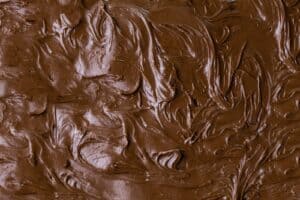When it comes to the world of chocolate, there’s no shortage of amazing flavors and varieties. Unsweetened chocolate, as the name implies, lacks the sugar found in other variations like milk chocolate or semisweet chocolate. This type of chocolate is primarily used in baking, providing a rich chocolate flavor without added sweetness. As a main ingredient in many recipes, an unsweetened chocolate baking bar is often combined with other ingredients like cocoa butter, sugar, and vanilla to create delicious desserts.
Unlike milk or sweetened chocolate, unsweetened chocolate contains almost pure chocolate liquor, a product obtained from grinding roasted cacao beans. Cocoa powder is the result of processing that same chocolate liquor once some of the cocoa butter has been removed. Although dark chocolate chips and unsweetened cocoa powder can be more popular choices in recipes, many bakers still prefer using unsweetened chocolate for its richer taste and higher fat content. A chocolate bar with subtle notes of flavor derived from the cacao beans can add depth to recipes like brownies, cakes, and other dessert creations.
Uncover the extensive benefits of cocoa butter and how this natural ingredient can elevate your skincare routine by visiting Cocoa Butter Benefits.
Working with unsweetened chocolate can take some getting used to, especially when it comes to balancing flavors. Adding ingredients such as maple syrup, eggs, and vanilla can help to offset the tart taste of the chocolate. When mixing in a stand mixer, be sure to first combine all the dry ingredients before adding the wet ingredients to ensure the ideal texture for your baked goods. Over time, experimenting with various chocolates, beans, and other ingredients can lead to the discovery of new and enticing recipes that satisfy your sweet tooth while still offering the bold, uncompromised flavor of unsweetened chocolate.

The Origins of Unsweetened Chocolate
I’ve always been fascinated with the origins of unsweetened chocolate, and how it has evolved into what we know today. It all started with ancient Mayan and Aztec civilizations, who used cacao beans to make a bitter, frothy beverage. This early form of chocolate was unsweetened and often enjoyed as a ceremonial drink.
As time went on, Spanish explorers discovered the cacao beans and brought them back to Europe. From there, people started experimenting with different ways to use and process the beans. This experimentation led to the creation of a paste known as chocolate liquor, a crucial ingredient in making unsweetened chocolate.
Delve into the calming and therapeutic advantages of incorporating chocolate into your self-care and well-being practices by exploring Chocolate as a Form of Self-Care and Well-Being.
Unsweetened chocolate is made by mixing chocolate liquor with cocoa butter, and little to no sugar or flavorings are added. It is commonly available in the form of an unsweetened chocolate baking bar. Pure chocolate liquor is the foundation for all chocolate, including unsweetened chocolate, bittersweet chocolate, semisweet chocolate, and milk chocolate.
Unsweetened chocolate is vastly different from sweetened chocolate varieties such as milk chocolate and semisweet chocolate. It has a dense and tart flavor, making it ideal for baking and cooking. Unsweetened chocolate is found in many favorite recipes, including brownies, cake, and even savory dishes that call for added depth of flavor.
Discover the unexpected benefits of chocolate for dental health in our article on Chocolate and Dental Health.
Choosing the right chocolate for your recipes is important, and there are a few key differences to consider:
– Unsweetened chocolate: Contains cocoa powder and cocoa butter, with no sugar added.
– Bittersweet and dark chocolate: High cocoa content but contains sugar. Bittersweet has slightly more sugar than dark chocolate.
– Semisweet chocolate: Similar to dark chocolate but with more sugar.
– Milk chocolate: Contains added milk and lower cocoa content, making it sweeter and creamier than dark, bittersweet, or semisweet chocolate.
When using unsweetened chocolate in baking, it’s essential to balance the other ingredients in your recipe. Adding sweetness and moisture through other elements, such as maple syrup, vanilla, and eggs, can help achieve a well-rounded flavor. Using a stand mixer can ensure all dry ingredients are thoroughly combined with the chocolate, resulting in a more even bake and a smoother finished product.
Experimenting with unsweetened chocolate opens up a world of new flavors and textures. Its unique taste profile allows for the creation of sophisticated desserts with subtle notes that other types of chocolate don’t offer. So go ahead, start playing around with unsweetened chocolate in your recipes and see what delicious creations you can concoct!
Exploring the Health Benefits
When it comes to unsweetened chocolate, I often find myself marveling at the numerous health benefits it provides. Surprisingly, it’s not just a treat meant for baking. Here’s what sets unsweetened chocolate apart from its sweet counterparts like milk chocolate and sweetened chocolate.
Firstly, the absence of sugar in unsweetened chocolate makes it a healthier option for those looking to cut down on their sugar consumption. It’s made from pure cocoa liquor, without any added ingredients, retaining all the rich flavor of the original cacao beans. This makes it a perfect choice for recipes that call for added sweeteners like maple syrup and vanilla. In contrast, milk chocolate is often packed with sugar, which can lead to health issues if consumed in excess.
Delve into the calming and therapeutic advantages of incorporating chocolate into your self-care and well-being practices by exploring Chocolate as a Form of Self-Care and Well-Being.
Secondly, because unsweetened chocolate has a higher percentage of cocoa solids, it naturally contains more cocoa butter than other forms of chocolate. Cocoa butter is a natural fat that’s rich in flavonoids and antioxidants, which have been shown to provide a variety of health benefits such as:
– Reducing inflammation
– Improving brain function
Additionally, the subtle notes of tart and bittersweet flavors in unsweetened chocolate often make it a favorite choice in dessert recipes like cakes, brownies, and chocolates. Unsweetened chocolate baking bars or dark chocolate chips can be used to give your baked goods a rich and deep chocolate flavor.
Another benefit of using unsweetened chocolate is its versatility. When you opt for unsweetened cocoa powder or chocolate liquor, you have more control over the fat content and sugar levels in your recipe. This allows you to create healthier versions of your favorite desserts by incorporating other ingredients like eggs, vanilla, and healthy sweeteners.
Lastly, the distinct taste of unsweetened chocolate lends itself to a wider range of flavors and recipes. It can be used in both sweet and savory dishes, as the lack of sugar allows for enhancing the flavor profiles of other ingredients. This makes it easy to tailor your recipe for individual tastes, as you can adjust the sweetness and flavors accordingly.
In summary, not only does unsweetened chocolate provide a healthier alternative to sweetened chocolates, but it also allows for an unmatched versatility in recipes. The range of health benefits, unique taste, and ability to be used in various dishes make unsweetened chocolate a wonderful addition to any pantry. So the next time you’re whipping up a dessert or looking for a new recipe to try, don’t hesitate to reach for that unsweetened chocolate bar!
Cooking with Unsweetened Chocolate

When it comes to working with unsweetened chocolate, it’s important to remember that this type of chocolate has a stronger, more intense flavor compared to sweetened options like milk chocolate or semisweet chocolate. Many bakers prefer using unsweetened chocolate baking bars for their cocoa powder content and full-bodied chocolate flavor.
There’s more to unsweetened chocolate than just baking bars, though. Cocoa butter, dark chocolate, dark chocolate chips, and unsweetened cocoa powder all fall within the category of unsweetened chocolate products. These variations of the ingredient offer different textures and flavors to your recipes, from cakes and brownies to savory dishes.
Unsweetened chocolate, in its natural form, is derived from chocolate liquor – a paste produced by grinding cacao beans. This paste consists of cocoa solids and cocoa butter, which give chocolate its intense flavor. The absence of added sugar or any other sweetening agents is what makes unsweetened chocolate different from its sweetened counterparts.
When substituting unsweetened chocolate with other ingredients, such as cocoa powder or sweetened chocolate, it’s essential to adjust the recipe’s sugar content accordingly. For every ounce of unsweetened chocolate needed, you can exchange it with three tablespoons of unsweetened cocoa powder and an additional tablespoon of fat, such as melted butter. Alternatively, if you’re substituting sweetened chocolate, make sure to reduce the sugar content in the recipe to balance the sweetness.
Here are some ways to make the most of unsweetened chocolate in your baking and cooking adventures:
1. Brownies: Combine dark chocolate chips, sugar, vanilla, cocoa powder, and eggs to create a rich, dense dessert. The intense chocolate flavor will shine through, and you can always adjust the sweetness with maple syrup or other sweeteners.
2. Chocolate Cake: For a rich, indulgent chocolate cake, unsweetened chocolate baking bars provide the perfect balance in your recipe. These bars combine well with other ingredients like vanilla, tart fruits, and subtle spices, enhancing the overall chocolate experience.
3. Tarts and Pies: Unsweetened chocolate can make for a deep, luscious filling in your favorite dessert treats. Blend it with butter, sugar, and eggs to create a velvety chocolate filling, then top it off with whipped cream or fresh berries for added dimension and flavor.
When working with unsweetened chocolate, it’s always a good idea to use a stand mixer for mixing your ingredients thoroughly. This will ensure that the right amount of air is incorporated into the mixture, resulting in lighter, fluffier textures. Additionally, don’t forget to sift your dry ingredients (like flour, sugar, and cocoa powder) to distribute them evenly throughout the batter.
In conclusion, unsweetened chocolate offers a world of possibilities for those looking to experiment with intense cocoa flavors. It may require some adjustments in your recipes, but the rich, full-bodied taste will make it worth the extra effort. Happy baking!
Final Thoughts
Throughout this article, I’ve discussed the various aspects of unsweetened chocolate and how it differs from other types of chocolate like milk chocolate and dark chocolate. The unsweetened chocolate baking bar is a versatile ingredient that contains cocoa butter and chocolate liquor, without added sugar. It can serve as an ideal base for recipes that require a more intense chocolate flavor.
Using unsweetened chocolate allows me to control the sweetness of my baked goods by incorporating sweeteners like maple syrup or other sweetened chocolate options. This can lead to a personalized balance between bittersweet and semisweet flavors, catering to diverse taste preferences.
When working with unsweetened cocoa powder, it’s essential to remember that its fat content is lower than that of a chocolate bar. This can affect the texture of recipes such as cakes and brownies, requiring adjustments to other ingredients like eggs and butter. But it’s important not to worry; with a few tweaks, it’s possible to achieve excellent results.
Let’s recap some key points about unsweetened chocolate:
– Derived from cacao beans, exhibiting subtle notes of natural flavors
– Does not contain sugar, allowing control over sweetness in recipes
– Can be found in various forms like chocolate chips or powder
– Can be used in a wide range of desserts and baking recipes
Incorporating unsweetened chocolate and other ingredients like vanilla and tart fruits can create unique flavor combinations that delight dessert lovers. It’s crucial, however, to pay close attention to my recipe’s dry ingredients, using a stand mixer when necessary for an even blend.
Ultimately, unsweetened chocolate is a versatile and valuable ingredient in any baker’s pantry. It lends a rich and deep taste to recipes, allowing us to create deliciously complex yet wonderfully balanced confections. So why not experiment with this amazing ingredient and discover new ways to impress your friends and family through irresistible chocolate treats?
- What Was The Original Purpose Of Chocolate
- What Skills Are Needed To Be A Chocolatier
- What Is Unsweetened Chocolate
- What Is The Most Popular Chocolate
- What Is The Best Chocolate For Fondue
- What Is Single Origin Chocolate
- What Is Kosher Chocolate
- What Is Compound Chocolate
- What Is Chocolate Liquor
- What Is Bittersweet Chocolate
- What Is A Christmas Chocolate Yule Log
- What Is A Chocolatier
- What Did A Bar Of Chocolate Prompt The Creation Of
- What Are Cocoa Nibs
- What Are Chocolate Truffles
- What Are Chocolate Bonbons
